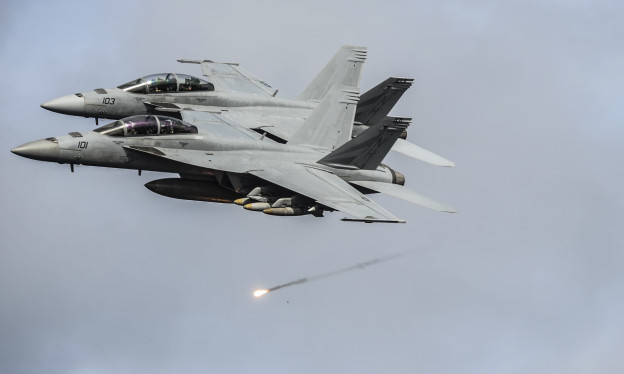
The U.S. Navy marked the Boeing F/A-18 Hornet’s 35th anniversary with the fleet on a Monday at a ceremony at Naval Air Station Patuxent River, Md.
“The F/A-18 and EA-18G program continue to thrive,” said Capt. Frank Morley, Naval Air Systems Command’s (NAVAIR) manager for the Hornet and Growler programs. “And [it] is by far the most predominant tactical force in naval aviation both in the United States Navy and the United States Marine Corps.”
The Navy is continuing to procure Super Hornets and Growlers through the President’s budget proposal for Fiscal Year 2014. But that budget is expected to be the last year in which funding is included for additional jets. Production is currently slated to end in 2016 unless the Navy procures more aircraft or the Congress adds more airframes to the budget.
So far the Navy has taken delivery of more than 490 Super Hornets with a total projected buy of 563. The service also has taken delivery of 90 of the EA-18G electronic attack variant, with a total projected purchase of 135 Growlers. The Pentagon has increased the production numbers for the Growler twice—first by 26 aircraft and a second time in the FY 2014 budget proposal by 21 units to compensate for the pending retirement of the Marine Corps’ Northrop Grumman EA-6B Prowler fleet. “We will continue production as the [DOD] decides,” Morley said.
Nonetheless, Boeing is confident that the Navy will pursue additional Super Hornet orders in the 2015 budget and beyond. “There is no planned shutdown of the production line,” said Mike Gibbons, Boeing’s vice-president for Super Hornet programs. Gibbons noted that the Pentagon would have to award the company a contract potentially worth “several hundred million dollars” to shut down the production line, store the tooling, and so forth.
In fact, Boeing might consider self-funding long-lead items to keep the production line going in the absence of U.S. government purchases—up to a point. Boeing would have to make that decision in March 2014, Gibbons said, but would only fund further production if it makes sense to do so from a business point of view. “It’d be tens of millions,” he said of the costs, however the company would not build so-called “white tails” — aircraft without a commitment from a customer.
Boeing would be able to cut the Super Hornet’s production rate from the current 48 per year to 24 and still maintain a similar cost structure. “Our practical minimum is two jets per month,” Gibbons said. The Boeing portion of F/A-18 costs—which does not include the General Electric F414 engines or the Raytheon-built electronic warfare suite—is just over $37 million. Under a reduced production rate, Boeing would expect to maintain that price, Gibbons said. The fly-away cost for the Super Hornet is less than $55 million, while the Growler costs roughly $9 million more.
Potentially, Gibbons said, he could envision the Super Hornet in production through 2020.
Meanwhile, the Navy has to extend the life of the older A through D model airframes, which continue to be the USMC’s primary fighters, until the Lockheed Martin F-35B Joint Strike Fighter (JSF) replaces them. “The need to keep this aircraft flying and relevant continues,” Morley said.
Morley said that induction of legacy Hornets into a service-life extension program (SLEP) will peak over the next several years. The goal is to increase the structural life of the Hornet airframe past 8,000 hours to 9,900 hours. In fact, one aircraft has already accumulated more than 9,000 hours. The jets originally were designed for a 6,000-hour service life. Thus far, Morley said, 100 F/A-18s (A through D models) have undergone the SLEP program.
The Super Hornet, too, will have to last for at least 9,000 hours, but given the lessons learned from the legacy Hornet model structural upgrades, it should be much easier to keep the F/A-18Es and F/A-18Fs flying beyond 2030, Morley said. Moreover, Boeing designed the Super Hornet having learned lessons from the construction of the legacy Hornet.
The Navy also is planning a host of mission-systems upgrades to keep the F/A-18E/F relevant into the mid-2030s when it is expected that a new F/A-XX aircraft will replace the Super Hornet. Among the upgrades is a addition of a long-wave internal infrared search-and-track system mounted in an external fuel tank.
Some additional upgrades might include select capabilities such as Boeing and Northrop’s conformal fuel tanks—which were recently demonstrated over the summer on a modified F/A-18F. “They are interested in the conformal fuel tanks, for instance, on the Growler,” said Rear Adm. Donald Gaddis, NAVAIR program executive officer for tactical aircraft. But the admiral stressed that the decisions to upgrade the Super Hornet or Growler are made independent of the development or fielding of the carrier-based F-35C. “Those sort of decisions are not made vis-à-vis JSF.”
As for what the F/A-XX might look like, the Navy does not yet have any firm ideas. “We’re in the very early stages of F/A-XX thinking,” Gaddis said. “I would really say that concept is still at this point in time in its infancy.”
Nonetheless, at some point, the Super Hornet airframe will inevitably have to be replaced—taking into account the 9,000-hour structural life of the F/A-18E/F. “At some point we do have to replace that platform,” Gaddis said.





